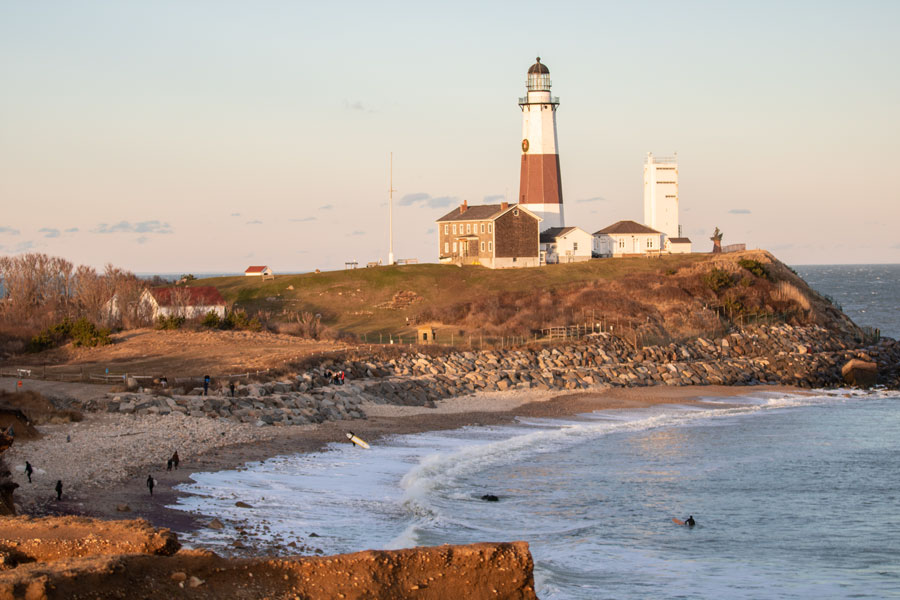19th Century & The Rise of Gold Coast

The 19th century was a transformative period for Long Island, marked by maritime heritage, political prominence, and the arrival of extreme wealth along its North Shore. From the construction of Montauk Lighthouse in 1796 to Theodore Roosevelt’s Sagamore Hill estate and the rise of the famed Gold Coast Mansions during the Gilded Age, this era left behind some of Long Island’s most iconic historic landmarks. These sites continue to attract visitors today, offering a glimpse into the island’s past as a place of strategic importance, cultural leadership, and extravagant luxury.
Montauk Lighthouse (1796)
- History: Commissioned by President George Washington in 1792 and completed in 1796, the Montauk Point Lighthouse is the oldest lighthouse in New York State.
- Purpose: Built to guide ships through the treacherous waters off Long Island’s eastern tip, the lighthouse played a critical role in maritime safety and commerce.
- Legacy: Today, the lighthouse is a National Historic Landmark and one of Long Island’s most visited attractions, offering panoramic views of the Atlantic Ocean and Block Island Sound.
- Visitor Experience: The museum showcases maritime history, Revolutionary War artifacts, and exhibits about the Montaukett Native American tribe.
Sagamore Hill – The Summer White House
- Location: Oyster Bay, North Shore of Long Island.
- History: Home of President Theodore Roosevelt, completed in 1885. Roosevelt lived there for over 30 years, and it became known as the “Summer White House” during his presidency.
- Significance: Many key decisions of Roosevelt’s administration were made here, including matters of diplomacy, conservation, and military policy.
- Legacy: The estate, now part of the National Park Service, is preserved as a museum. Visitors can tour Roosevelt’s home, see personal artifacts, and walk the surrounding 83 acres of gardens, fields, and woodlands.
The Gold Coast Mansions (1890s–1930s)
The Gilded Age on Long Island
During the late 19th and early 20th centuries, Long Island’s North Shore became a playground for America’s wealthiest families. Captains of industry and finance built sprawling estates that showcased their fortunes, rivaling the grand homes of Europe. This period became known as the Gold Coast Era, inspiring F. Scott Fitzgerald’s The Great Gatsby.
Notable Mansions & Estates
- Oheka Castle (Huntington): Built in 1919 by financier Otto Kahn, Oheka is the second-largest private residence ever built in the U.S. Today, it operates as a luxury hotel and event venue.
- Sands Point Preserve (Port Washington): Once home to the Guggenheim family, the estate features massive castles and lush grounds along Long Island Sound.
- Old Westbury Gardens: Built in 1906 by John S. Phipps, this English-style estate includes formal gardens, woodlands, and landscaped grounds, open to the public for tours and events.
- Planting Fields Arboretum (Oyster Bay): The former estate of William Coe, now a public arboretum and state park.
Cultural Legacy
- These estates hosted presidents, celebrities, and social elites, shaping Long Island’s image as a symbol of luxury.
- Many have been preserved as museums, parks, or cultural centers, while others serve as backdrops for films, weddings, and community events.
Quick Snapshot
| Landmark | Built | Significance |
|---|---|---|
| Montauk Lighthouse | 1796 | Oldest lighthouse in NY, commissioned by George Washington |
| Sagamore Hill | 1885 | Home of President Theodore Roosevelt, “Summer White House” |
| Oheka Castle | 1919 | Lavish Gold Coast mansion, now luxury hotel/events venue |
| Sands Point Preserve | 1900s | Guggenheim family estate, now historic preserve |
| Old Westbury Gardens | 1906 | English-style estate and gardens, open to public |
The 19th century and Gold Coast era shaped Long Island’s identity as both a place of strategic importance and extravagant wealth. From guiding sailors at Montauk Point to shaping national policy at Sagamore Hill, and hosting America’s elite in the Gold Coast mansions, these historic sites remain among the island’s most treasured destinations. Visiting them today offers a rare opportunity to step back into an age of maritime resilience, presidential leadership, and Gilded Age grandeur.

